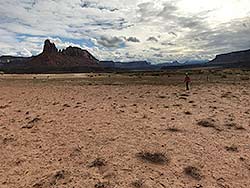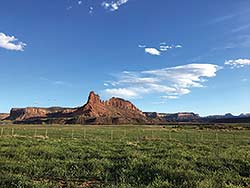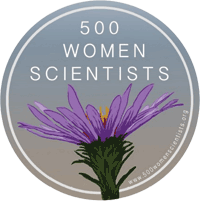 When was the last time you were outside, perhaps on a hilltop or at the mouth of a canyon, facing the subtle palette of greens and red-browns that embody the arid landscape of the Canyon Country desert? What did you see? Perhaps beauty, perhaps a sick splitter on the Wingate above you, or a 2-track stretching into the distance. Supporting the aesthetic wonder of our desert are the bedrock geology, the soil, the interwoven ecosystem itself. When was the last time you were outside, perhaps on a hilltop or at the mouth of a canyon, facing the subtle palette of greens and red-browns that embody the arid landscape of the Canyon Country desert? What did you see? Perhaps beauty, perhaps a sick splitter on the Wingate above you, or a 2-track stretching into the distance. Supporting the aesthetic wonder of our desert are the bedrock geology, the soil, the interwoven ecosystem itself.
In addition to the adventure and inspiration our landscape provides, ecosystems offer some critical services that often go undetected until disrupted. When plant and soil components of our environment are lost, we inevitably see a decline in these inherent services. What ecologists and land managers aim for when they set out to restore damaged landscapes is to recreate resilient ecosystems and reinstate their services.
But how do we do restoration? For one thing, it’s not exactly gardening! We have very limited, if any, ability to irrigate and native plants often remain dormant rather than green-up on cue. We also work in a context of feedbacks, or natural processes that reinforce degraded conditions. Consider this common scenario: perennial plants and biological soil crust are trampled, exposing soil to erosion. Healthy topsoil washes away, and replacement seedlings and crust face a now nutrient-poor environment, no adult plants to shelter seedlings from drying winds, and a real possibility of being buried under a layer of windblown dust… And so it goes: degradation reinforces degradation. 
To restore a functioning ecosystem, ecologists take actions to counteract the feedbacks that create barriers to recovery. Colorado Plateau scientists are building on previous attempts and deploying innovative new methods, even borrowing ideas from other fields. To stabilize soil, ecologists hummock (mound) soils to prevent gullies from forming, or add organic tackifiers that temporarily glue soil particles together. To recreate soil fertility, barriers can be erected that trap plant debris carried by wind, and humic acid can be added to kickstart the soil microbiota so it digests organic material into nutrients that feed plants. Recent research is testing whether biological soil crust can be grown then used to inoculate degraded areas in favorable seasons. Ecologists are also testing novel planting techniques including erecting barriers made from natural or artificial materials to provide shade and wind protection for seedlings, or using small depressions or mulch to increase soil moisture available to plants.
The job is still fraught with challenges. Managers have tried mowing, burning, spraying, and pulling weeds, and researchers are investigating biological controls but invasive species are still a significant barrier to reestablishing desired plants. The changing climate creates an uncertain future and has managers considering “Pre-storation” – planting species adapted to warmer climates as a means to prepare landscapes for inevitable change. And cost is also essential, even tactics that are effective won’t be used on a large scale if they aren’t affordable.
The more we work together to find creative solutions, the better. Right here in our own community, government agencies, non-profits, and private industry are tackling restoration challenges. The next time you’re outside scanning the desert, consider all it’s giving back to us human visitors. If you spot some troubled areas that look overrun or invaded by a monoculture of cheatgrass perhaps you’ll even start scheming of some creative ways to counteract those forces. You’ll be in rank with a myriad of scientists working behind the scenes right here on the Colorado Plateau.
 Southeast Utah 500 Women Scientists
Mission and Values: Southeast Utah 500 Women Scientists
Mission and Values:
Our Mission:
• To share the importance of science.
• To support one another as a community of women scientists in Southeast Utah
• To be in service in the name of science to the communities of Southeast Utah.
Our Values
Being a supportive group for women scientists in Southeast Utah
Advocate for inclusivity in our group and in science at large
Increase scientific literacy for locals and tourists
Mentor and support students of science (especially girls) |
|